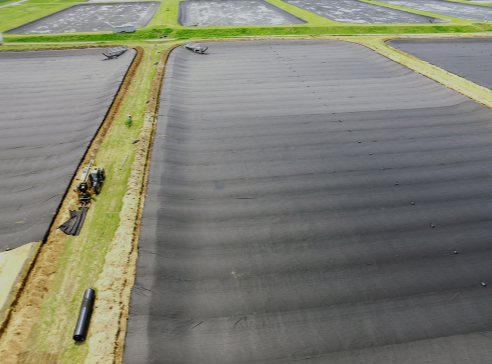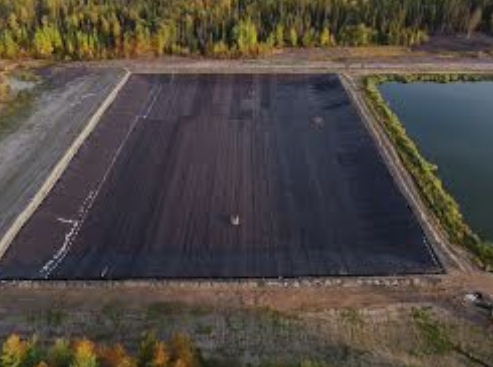- Understanding the Role of Geomembrane Liners in Waste Management
- Innovations in Geomembrane Liners for Water Management
- Geomembrane Liners: A Comprehensive Guide
- The Future of Geomembrane Liners in Civil Engineering
- Geomembrane Liners: Enhancing Landfill Stability
Manager:Alvin Wang
WhatsApp:+62 8983806051
Tel:+86 10-5797-1075
Email:steelwang@okorder.com
Address:3rd Floor, No.2 Building, No.1 Sanlihe Road
Does HDPE geomembrane leach into water?
hdpe Geomembranes are known to be effective liquid barriers for different civil engineering and environmental applications. It is the best choice for lining landfills, ponds, reservoirs, and other containment structures due to its impermeability and chemical resistance. However, some have raised concerns concerning the possible migration of contaminants from HDPE geomembrane into water bodies surrounding it. This article seeks to establish whether or not HDPE geomembrane leaches into water.

1 Understanding HDPE Geomembrane
However, before getting into the leaching properties of HDPE geomembrane, one must first understand its composition and properties. It is a synthetic liner made from high-density polyethylene (HDPE) resin. This kind of thermoplastic material is famous for being durable, flexible and having resistance against chemical corrosion as well as punctures or UV degradation. To meet specific project requirements, HDPE geomembrane is manufactured using processes such as extrusion, blending and thermal welding that creates seamless liners.
2 Chemical Composition
HDPE geomembranes are made mainly from high-density polyethylene which is a polymer consisting of long chains made up of ethylene monomer units. The chemical structure of HDPE makes it highly resistant to various chemicals such as solvents acids alkalis hydrocarbons among others . Additionally ,HDPE formulations for geomembanes could include additives like antioxidants ,UV stabilizers ,and processing aids to enhance their performance and life.
3 Leaching Mechanisms
The process by which chemicals or contaminants move outwards from a solid material into surrounding water or soil is referred to as leaching. In the case of HDPE geomembranes this can occur through processes like diffusion,sorption and desorption .
4 Diffusion
The primary mode through which small molecules or ions transit across the molecular structure of an HDPE geomenbrane is diffusion . Even though low permeability makes HDPE almost impermeable to diffusion, some chemicals with small molecular sizes may still be able to penetrate the geomembrane over time. The extent of diffusion depends on parameters such as temperature, concentration gradient and chemical characteristics of the contaminant.
5 Sorption
It is a process in which various contaminants adhere or absorb on the HDPE geomenbrane. Despite being relatively inert and non-reactive, certain types of chemicals may have an affinity for the surface of a geomenbrane thereby leading to its adsorption or deposition on the surface. This behavior can occur for both organic and inorganic pollutants based upon their solubility and molecular interactions with geomenbrane .
6 Desorption
The release of previously sorbed contaminants back into surrounding water or soil is known as desorption. In this case changes in pH ,temperature, hydraulic conditions among others can affect the rate at which desorption takes place . Although HDPE has low desorption rates because it essentially stays inert, long term exposure to harsh chemicals or environmental stressors may enhance the likelihood of desorption.
7 Environmental Factors
Temperature, pH, hydraulic conditions and exposure duration are several environmental factors that can influence leaching behavior of HDPE geomembranes.Temperatures above normal degrees combined with acidic or alkaline pH levels will hasten movement and adsorbtion of contaminants while variations in hydraulic gradients could alter leachate transport across geomenbrane system.
8 Regulatory Standards
In order to address concerns about possible contamination from HDPE geomembranes guidelines set by industry players and regulatory bodies specify allowable limits for geomembrane materials.These standards may dictate maximum allowable concentrations for specific pollutants in leachate samples collected from installations having geomembranes . Adhering to such global stipulations means that liners made from these materials meet stringent quality assurance as well as performance criteria relevant for environmental safeguarding.
9 Mitigation Strategies
Despite the fact that the chances of leaching out of HDPE geomembrane are usually minimal, there are many mitigation strategies which can be adopted to minimize potential effects on water quality and environmental health. Several of these strategies include:
- Resin Formulation Selection: Use of HDPE geomembranes with low extractable contents and minimum additive amounts helps to reduce the risk of contaminant leaching.
- Geomembrane Compatibility Testing: When HDPE geomembrane is tested against specific site contaminants, its appropriateness will be known so as to prevent any leaching risks.
- Hydraulic Design Considerations: Leachate collection systems, drainage systems, among other hydraulic controls should be incorporated in the design of geomembrane containment systems in order to avoid movement of pollutants through the membrane.
- Monitoring and Maintenance: Regular monitoring and maintenance measures like sampling and analysis of leachate make it possible to identify any cases of leaking before they get worse.

10 Conclusion
Lastly, even though HDPE geomembrane membranes have been acknowledged for their strength and chemical resistance, worries about seeping into water necessitate a cautious outlook. Therefore, understanding mechanisms underlying leaching from an HDPE geomembrane is necessary for managing risks resulting from these threats on water quality and environmental health. This will ensure safe use and good performance by employing appropriate mitigation approaches set within legal frameworks by engineers and environmentalists dealing with containment applications using HPDE as described herein.
-
2024-12-05Geomembrane Liners: A Comprehensive Guide






